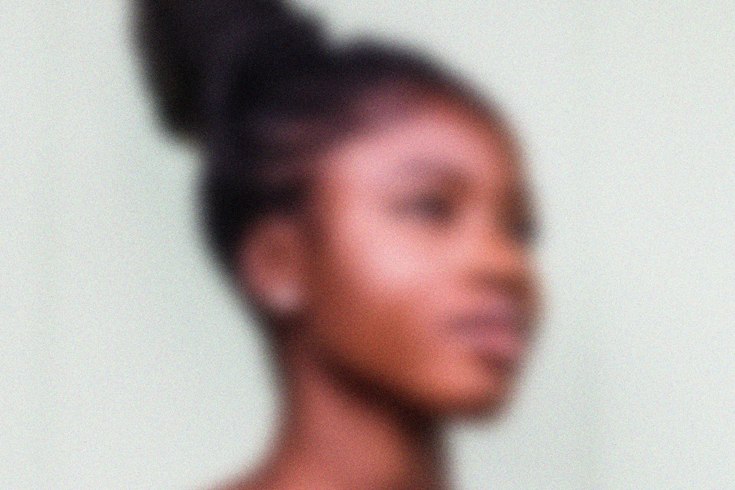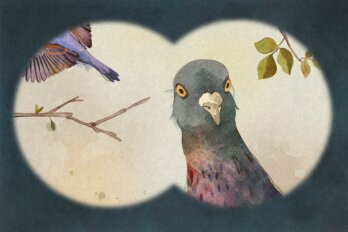“Eternity,” my mother’s friend Angela said sternly, taking a sip of the Tim Hortons coffee she held in one hand as she pointed at me with the other. My mom and I were sitting on milk crates in Angela’s garage as we did most nights—the two of them with their caffeine and cigarettes and me with my chocolate milk. “If anyone calls you a nigger, you break their fucking nose.” She then proceeded to take my hand and show me the exact force I would need to accomplish this assault.
I wasn’t yet eleven.
Angela made me practise over and over, readjusting my flexed wrist, reminding me what part of the nose would need to come in contact with the heel of my palm for maximum damage.
If anyone was going to teach me how to do a palm strike, it was Angela. She was a butch lesbian not out to her Catholic mother, who was still trying to find a good man for her thirty-something-year-old daughter. I didn’t know what the word nigger meant or why I would need to hurt someone who said it. I looked to my mother for clarity, but she remained silent. Angela sensed my confusion. “Nigger is said by people who hate other people because of the colour of their skin,” she explained.
I arrived at the intersection of two brown families from different castes and ethnicities. My maternal grandfather is the son of Mangalorean parents but was born and raised in Karachi, Pakistan. He and his five siblings grew up without money; their father—my great-grandfather—was a cook for a well-off family that paid him ten cents a day. His family didn’t have necessities, like food or shoes, much less luxuries, like a camera to capture memories. As a child, my grandpa loved reading the news but couldn’t afford a newspaper, so he’d take the neighbours’ off the porch in the morning then return it before they woke up. To this day, he still wakes up at 5:30 a.m. to read the newspaper. My great-aunts and great-uncles were put into arranged marriages, but my grandfather fell in love with my grandmother, an Anglo-Indian woman who was a fellow member of a youth-leadership group in Karachi. And, against his parents’ wishes, he married her.
Anglo-Indians in Pakistan were people of both Indian and British parentage (also known as Eurasians), as well as Brits living in India. My grandma’s mother was Pakistani and her daddy was an Irishman who was left in Karachi by his father after the Second World War. Anglo-Indians had a bad rap in Pakistan. At the time of independence, there were about 500,000 of them, and many gained the distrust of Indian nationalists over their decision to identify with British rule. They also had a reputation of being partygoers and drinkers, always entertaining and living lavishly.
When my grandparents got married, they merged two families that had no business being together. Years later, much of our family on both sides made Canada their new home. At the parties that my grandmother hosted every Sunday, my grandfather’s family would sit on one side of the house, looking on quietly at my grandmother’s gregarious relatives.
There was whiteness in the family, but no one was prepared for a Black child—I had shaken up the family dynamic in a new way. At home with my family, I would sing along to songs from my favourite Bollywood film—Kuch Kuch Hota Hai, starring the dreamy, never-aging Shah Rukh Khan. I wore langas to weddings. My grandmother’s cooking, a reminder of Karachi, brought our displaced and homesick family together on Sunday afternoons, when my uncles and aunts addressed me by Urdu or Konkani terms of endearment as they pinched my cheeks. When my grandmother took me to her favourite Indian grocery store, the owner never looked at me any differently. At family parties or community events, I never felt out of place. Even at our favourite South Asian restaurants, they greeted me like an Indian child: How are you, beta?
But I was the odd one out—a brown-skinned girl with big curly hair. Even as different ethnic groups poured into Toronto, my family had their work cut out for them with a half-Black kid, and my father wasn’t around to help us understand my Jamaican heritage. While the ’90s saw the emergence of the mixed-race movement, biracial people were hard to come by. My tan-skinned, straight-haired mom and grandmother would drive to Buffalo, New York, just to find books with characters I could look up to and dolls that looked like me.
Even in her late twenties, my mother didn’t have a wrinkle or fine line in sight—she could easily have passed for a teenager. By then, she was rocking tattoos along her arms and chest and piercings on her face, accompanied by bleached-blond hair and pink lipstick—Snob by MAC was her favourite. She wore fitted Tommy Hilfiger ensembles and bandanas, and she was always yelling over the phone at some man who was five minutes late for their date, then counting down the time until he came back grovelling. I adored her beauty, brawn, and badassery. I was so happy to be hers. When we were together, I would wonder if I made her feel uncool.
When Amazing Amy came out in Canada, my mother couldn’t stop talking about how they had a Black doll. She stood in line to get me one in its massive green box. Amazing Amy was all the rage; she came with different kinds of food that you could feed her and different outfits. Black Amy was so pretty: cute little burgundy lips, deep brown skin, and curly black hair like mine. She was annoying with her constant whiny demands, though, so I fed her liver, which she hated, as payback.
I understood that Black Amy and I had the same skin colour and the same curly hair, and I knew that I looked different than my grandmother and mother. But I didn’t see that difference as division yet—we were just different shades. During arts and crafts time in kindergarten, I drew myself and my grandfather in brown crayon and the rest of my family in peach. We were still a family but in an assortment of body sizes and colours.
By grade two, I began to realize there was a difference associated with our skin colours. In my grandmother’s soaps, all the airtime went to the white (or, as I called them, peach) people, like Sharon Newman, the beautiful heroine on The Young and the Restless, who was blue-eyed with straight blond hair. In the tabloid magazines we kept in the house, peach people graced the covers. At school, I noticed the way teachers doted on the cute little peach girls but not on me, and how the peach girls’ cheeks turned a magical shade of pink in the winter—the way my grandmother’s did—but mine couldn’t, no matter how long I stood in the blistering cold. I watched the way my mother’s hair flattened like spun gold as she ran the straightening iron through it in preparation for a night out. I was mesmerized as she applied makeup to her flawless face; when she left for the night, I’d press my finger in her MAC Studio Fix powder and run it across my hand—an astounding contrast, like chalk on a blackboard.
My mother and grandmother were both closer to peach, but I was closer to darkness, and darkness was danger. Darkness was when I ran back into the house, smelling like the outdoors after playing with the kids on the block all day. It was when bad men drove around to lure little children into their cars by asking for directions. It was when the bogeyman under the bed made his move. Without realizing it, I had internalized a dislike of myself that I couldn’t articulate.
The first time my family had to address my Blackness was at my cousin’s house when I was nine. It was a party, and a young boy, distantly related to my cousin, came downstairs to the basement to play video games with the rest of us. He backed out of the room the moment he saw me. “She’s Black! I don’t want to play with Black people,” he yelled as he pointed at me. I told my grandfather what he said, and my grandpa confronted the boy’s parents. We never spoke about it again.
Later that year, I became best friends with two Lebanese girls who lived down the street. They called me Black all the time; I didn’t know why that mattered, but I knew I felt uncomfortable. I felt the reluctance of their father, too, when I came over for dinner. He could barely look me in the eye. When they invited me over during their family parties, the adults walked past me like I didn’t exist. One day, their baby cousin was over, staring at me, thumb in mouth, as I waved. “She’s scared of Black people,” her sister said. My mom gave their parents a proper schooling, and that was the end of the conversation.
My mom and I never discussed our contrasting features, even when I became a teen and servers started asking us if we wanted separate bills. Not even when she talked to strangers about her daughter and they asked, “Where is she?” as I, her lookalike, stood right there. And she didn’t feel the way I did when it came to my appearance. Boys didn’t turn her away because she was too dark. She wasn’t followed around department stores by old white ladies. She didn’t have to feel uncomfortable or nervous in the spaces white people inhabited. The small fraction of whiteness I inherited was nowhere near enough to pass like her.
My father’s name was rarely mentioned in our house unless I asked. And, even then, my mom gave me one-sentence answers. But I wanted to know what his identity contributed to my own. What did it mean to have a Black father? How could I bridge these two identities harmoniously? If he was out of the picture, did I have a right to call myself Jamaican? Could I be both—Black but still brown, brown but also Black?
To the mothers of my Black girlfriends, I was Black, and the percentage didn’t matter. When we turned thirteen and started going to the mall on our own, it was their families who taught me what my rights were in case the police stopped me, what stores sent security guards after Black kids, and what to say if I was falsely accused of shoplifting. Women like Angela, like these mothers, were the ones who first taught me how to navigate the world as a Black person, before I even knew what that would mean.
On my first day of high school, I took a seat beside another Black girl and got out my notebook. She stared at me intensely. I looked back at her, feeling insecure, but she didn’t break eye contact.
“What’s your background?” she asked.
I repeated what my mother always told people about me. “My mother is Pakistani and Irish and my dad is Jamaican.” The girl stared at me for a few seconds longer, nodded, turned back around.
This question became the main interaction I had with the other Black girls in high school, and each time, it was just as uncomfortable. I dreaded the pressure to describe myself in a few words, to decide what to include or exclude, to feel confident in my incomplete answer.
But, in a school full of teens who were also thinking about the nuances of their identities, I could start to think about my own. “Light skin” and “dark skin” teams were emerging, and kids were putting ls or ds beside their Facebook names. People wore their ethnicities with pride through their clothing or expressed their multiracial identities in the bios of their social media profiles, calling themselves mixed. The lighter you were, the more attractive; the less conventional your mix, the more desirable. Mixed wasn’t a word I liked, and anyway, it was usually reserved for white-Black or white-Asian biracial people. But it was what the Black kids called me. Everyone else referred to me as Black; the brown kids, though accepting of our shared ethnicity, couldn’t get past my appearance.
As a child, I’d spent so much time with Angela, sitting quietly on the milk crates in her garage, listening to her and my mom tell their profanity-laced stories while I drank chocolate milk. She knew I could never actually inflict the kind of assault she’d taught me, but that wasn’t the point. The palm strike wasn’t to show me how to break someone’s nose; it was to get me ready for the inevitable day when I would be angry and fed up and caught off guard by that word. Nigger. In a world that would often leave me feeling out of control, it gave me permission to harness that fury and anger. To have the option for revenge and decide not to use it—that was more potent than their words. That was power. And, if I were ever in danger, at least I’d know how to defend myself.
To live our lives unashamedly and openly, we always risk pain—at our own hands, at the hands of our families, at the hands of strangers. Angela knew that, and she knew I’d learn that too. She taught me that I had permission to feel that pain and react to it if I needed to; but most of all, she taught me that it would be an inevitable part of my life. Only I could decide if it would consume me.
I hope one day we meet again.
Excerpted from They Said This Would Be Fun by Eternity Martis. Copyright © 2020 Eternity Martis. Published by McClelland & Stewart, a division of Penguin Random House Canada Limited. Reproduced by arrangement with the publisher. All rights reserved.





